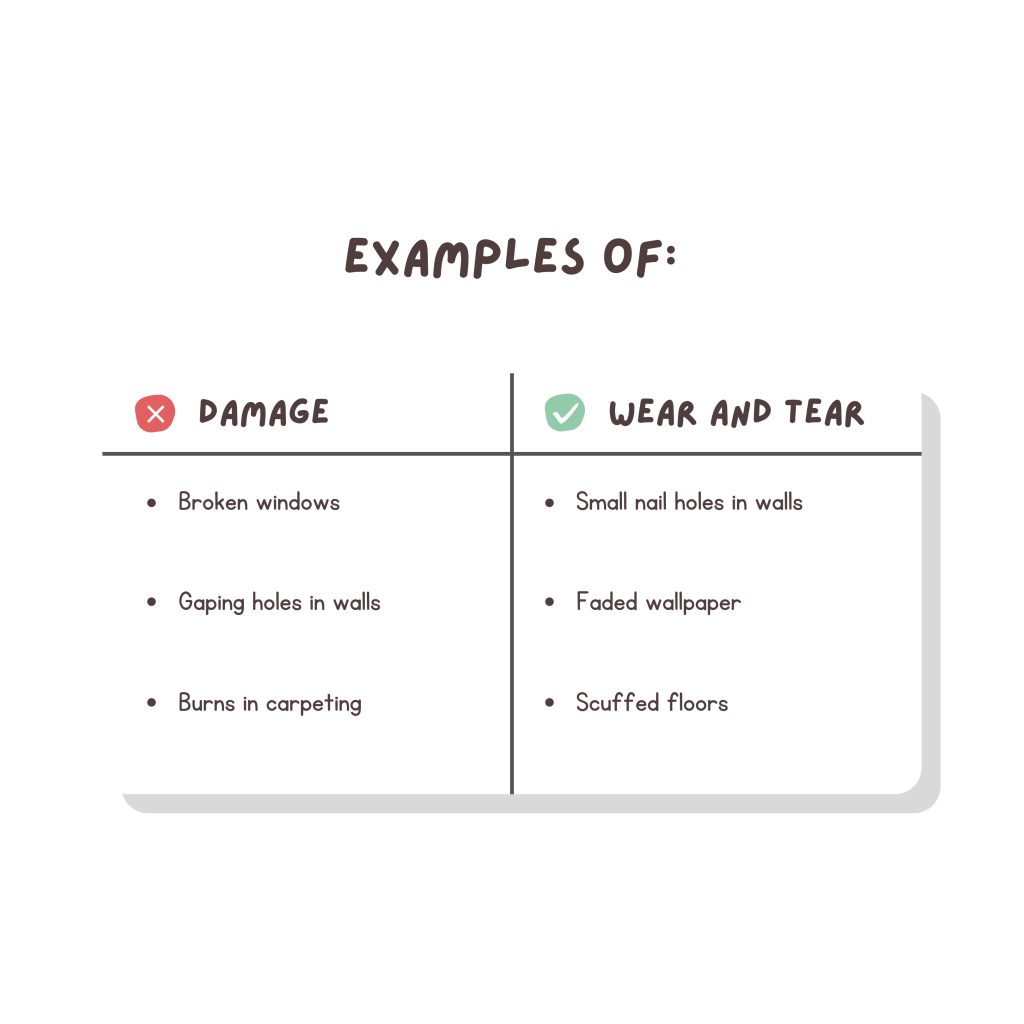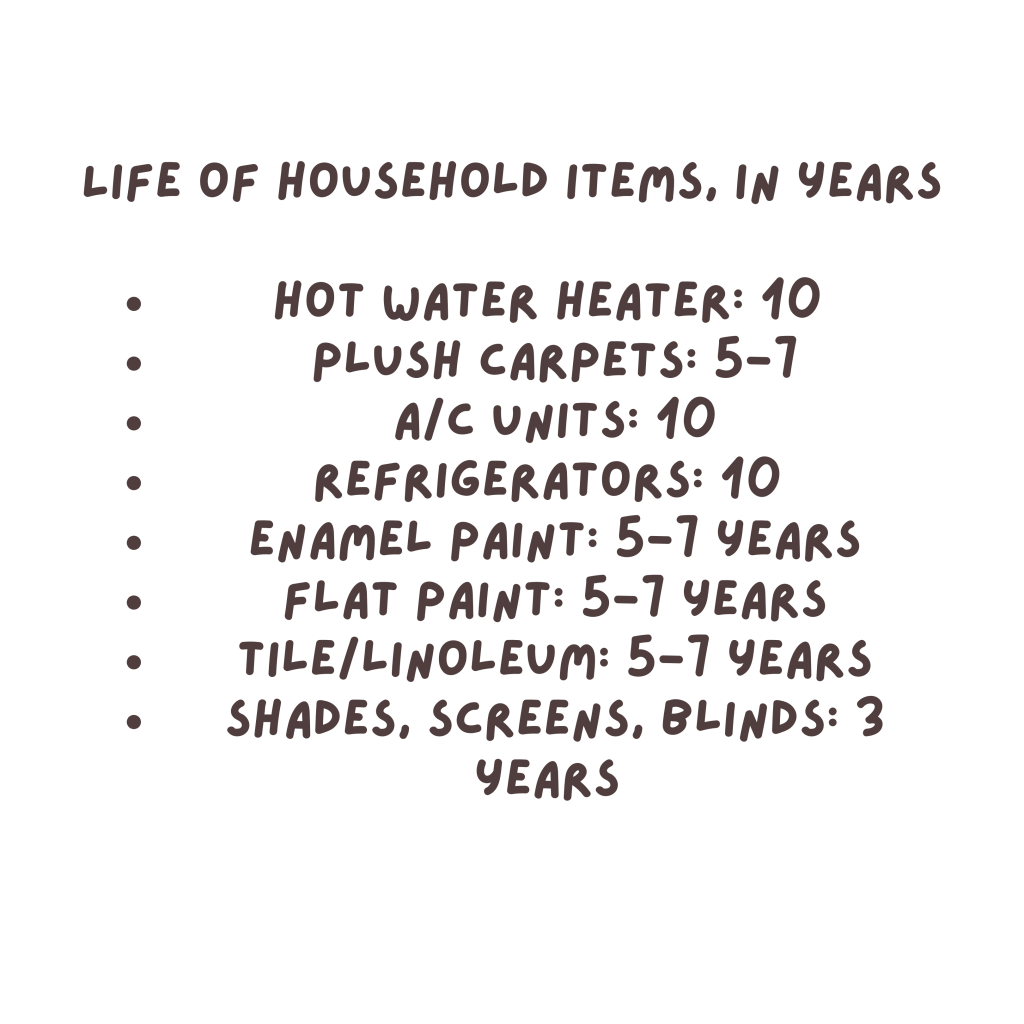If you’ve ever rented or rented out a property, you probably know it can be tricky for a landlord and tenant to amicably agree on how much of a security deposit should be returned at the end of a tenancy. A security deposit is an amount of money a tenant gives to a landlord before moving into a property. It gets used to fix damage to the property at the end of a tenancy and returned to the tenant if there isn’t any damage. (To find the laws about the procedure for returning security deposits in every state, click here.)
What gets complicated is determining the difference between “damage” and normal “wear and tear.” Wear and tear, or natural deterioration, is a fact of property ownership. Even a well-maintained, well-cared-for property is eventually going to show signs of age. Carpets fade. Paint peels. Rust appears. Refrigerators stop working. Like cars, properties require ongoing maintenance, from cleaning to painting, and there is general legal consensus in the United States that this maintenance is the property owner’s responsibility. It is the landlord’s legal duty to spend time and money making sure the property is hygienic and habitable.
A tenant can’t be expected to pay for upgrades to the property but can be held accountable and liable for excessive damages. A landlord is within her or his rights to withhold some or all of a security deposit to pay for damage that exceeds “wear and tear.”
So how do you discern the difference? Each state uses a slightly different set of rules. In this post, we’ll take a look at some of the terms and tips you’ll want to know before you rent (or rent out) another property.
Table of Contents
- Wear and Tear vs. Damage
- What’s the Life Expectancy of Household Items?
- How to Avoid Small Claims Court
Wear and Tear vs. Damage
Not every state has a statute that defines “wear and tear.” Some states do, namely Alaska, Colorado, Idaho, Maine, Nevada, Texas, and Vermont.1 Laws in all of these states define wear and tear as some variation of “deterioration which occurs without negligence, carelessness or abuse of the premises.”2 With the exception of Nevada, these states also consider “accident” to be grounds for a property damage claim.
But even in these states, courts often turn to case law for clarification. The line between wear and tear and damage can be confoundingly thin.

If you’re a landlord, you should expect your tenants to walk on the floor, open the doors, take showers, and generally use all the things you paid and pay to maintain. Maintenance is an operating cost if you’re running a rental business, which is essentially what you are doing.
Normal wear and tear can include nail holes, chips, dents, and even cracks in walls. It can look like faded paint or wallpaper, thin or worn carpet, scuffed floors, loose grouting, scratched enamel, and warped windows. Property damage, on the other hand, generally costs a considerable amount of money to fix. This can look like burns in the carpet, chipped floors, water stains, broken windows, cracked tiles, cracked mirrors, or gaping holes in the wall. A shoddy or unapproved paint job can also be characterized as property damage.3
A very simple strategy for determining the difference — before a judge has to — involves asking two questions. Was the property used as it’s intended to be used? (Did the tenants use the property to host frequent, rowdy parties? To run a dog-sitting business? Or to live and sleep in?) And does the deterioration seem glaring and excessive?
What’s the Life Expectancy of Household Items?
So how do you know whether something has simply reached the end of its useful life, or whether a tenant’s behavior caused its premature death? Things in a home that will stay behind after a tenant leaves are called “fixtures,” and these various parts of a home have generally accepted life spans. For example, plush carpeting is expected to last about five years. So if a tenant moves out five years after a carpet was replaced, it would be unreasonable for the landlord to charge the tenant for new carpeting. If, however, the carpet was replaced just before the tenant moved in, and after a year there are large stains through it, then the landlord may be within his or her rights to use some of the tenant’s deposit to cover the cost of fixing the carpet.
The U.S. Department of Housing and Urban Development (HUD) published a document called the Special Claims Processing Guide to clarify some of the confusion arising from these matters. The guide includes a chart that addresses the reality that household appliances and upgrades have a general “life expectancy.”4 Here are some of them:

It’s a good idea to check out the list itself, because there are some specific variations. For example, while hot water heaters have a standard life expectancy of ten (10) years, other items have a longer life expectancy for elderly tenants. Plush carpeting, for example, has a five-year life expectancy in a unit rented by a family, but a seven-year life expectancy for a home occupied by an elderly tenant. Both landlords and tenants can use this chart to make informed decisions about who’s responsible for paying for what.
How to Avoid Small Claims Court
Whether you’re a landlord or a tenant, there are things you can do to ensure the process of moving out is smooth and you don’t end up in court over a claim for damages.
If you’re a landlord, it’s a good idea to create a routine maintenance plan before you rent out your property. Map out what needs maintenance, from replacing carpeting to replacing your fridge, and when. You might also consider including examples of property damage in your lease agreement so as to eliminate the possibility of confusion later on.5 Another way to make sure you’re protecting your property is by carefully screening potential tenants — a process that may include talking to owners of other properties they’ve rented. You can’t discriminate against renters based on certain criteria, but you can choose not to rent your property to someone who’s been evicted for causing serious property damage. (Check out our previous blog post to get a better idea of what counts as discrimination under the Fair Housing Act.)
If you’re a tenant, it’s wise to clean your space well before you leave. You might even consider hiring someone to do this. It’s also a good idea to fix damage that’s easily fixable. Replacing a few light bulbs and plastering over a few nail holes in the walls can increase your chances of getting your security deposit back.
Probably the most effective way to avoid issues and disagreement is for both landlord and tenant to do a walk-through inspection on move-in day and move-out day. This inspection is like the one you do when you rent a car: you walk around the vehicle with a member of the rental agency’s staff, and you both note, on paper and through photographs, dings and dents and problems. You do this before you drive away so you can be sure that when you return the car, you won’t be charged for damage that existed before you even got there.
During your walk-through inspections, check the larger, more obvious items — walls, ceilings, floors — as well as the smaller details, such as outlets, towel racks, and vents.6 To download our comprehensive inspection checklist, click here. These inspections can give both landlord and tenant an idea of what existed prior to the tenancy and what exists as a result of it.
If, when the results of each inspection are compared, the damage seems glaringly obvious, then the landlord must create a detailed list of needed repairs and what they cost.7 This list must be presented to the tenant, who can then dispute the claim. In the most contentious of situations, these matters go to court, most commonly a small claims court. Documentation from each inspection can help the judge to reach a fair and evidence-based decision.
Check out our website for templates of other documents you need in this kind of situation, including lease agreements, security deposit return letters, and security deposit demand letters tailored to your specific state.
Sources
- https://ipropertymanagement.com/laws/normal-wear-and-tear#definition
- https://www.leg.state.nv.us/nrs/nrs-118a.html#:~:text=by%201977%2C%201331)-,NRS%20118A.,premises%20with%20the%20tenant’s%20consent
- https://www.apartments.com/rental-manager/resources/article/landlords-guide-to-normal-wear-and-tear-in-rentals
- https://www.hud.gov/sites/documents/HSG-06-01GHBGUID.PDF
- https://www.rentspree.com/blog/normal-wear-and-tear
- https://www.zumper.com/manage/resources/normal-wear-and-tear/
- https://www.findlaw.com/realestate/landlord-tenant-law/security-deposit-laws-can-help-get-your-deposit-back.html
